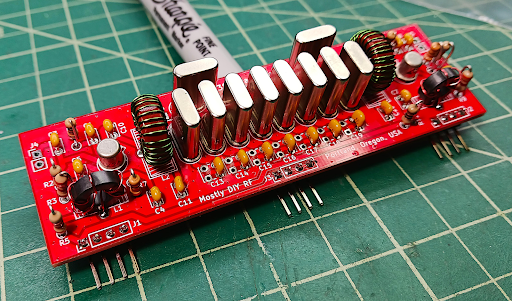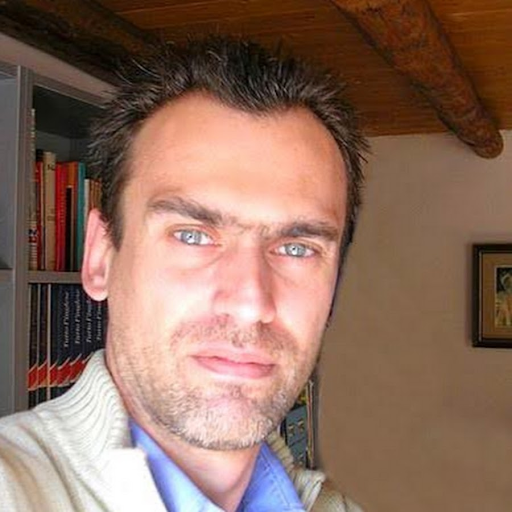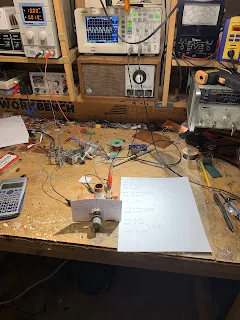Podcasting since 2005! Listen to Latest SolderSmoke
Thursday, November 30, 2023
AA9IL's Sputnik Tube, Altoids Tin Transmitter
Wednesday, November 29, 2023
Other Workshops: Genius Girl Fixes (Re-builds!) Old Tractor
Monday, November 27, 2023
Video on Discovery and Restoration of the Apollo Guidance Computer
Saturday, November 25, 2023
Some Short-Wave Listener QSL Cards
Friday, November 24, 2023
A FREE Book from the Early Days of Ham Projects with Transistors: The CK722 -- The Device that Got Pete Juliano Started in Homebrew
You can get the book for free here:
We are really lucky to have Pete Juliano sharing his vast tribal knowledge with us.
Thursday, November 23, 2023
Other Workshops: A Twin Cylinder Solenoid Electric Motor and some Very Cool Craftsmanship
Maceij's YouTube channel has many other projects, many like this one: https://www.youtube.com/@maciejnowakprojects
Thanks to HackaDay for the heads up.
Tuesday, November 21, 2023
On my Second Day on 10 meter AM, I Worked K5JC -- the Creator of the Mod that I was Using (Video)
See video above. This happened on my second day on 10 meter AM. I was using the little GE CB radio that I had modified for 10 meters. I had lucked out. First bit of luck: the CB that I bought (for parts!) at a hamfest turned out to be just the thing I needed for a quick and easy mod. The GE box had what is called a Hygain board and -- most important -- a PLL02 chip. Second bit of luck: I stumbled across an article by Jerry K5JC on how to put this particular kind of device onto 10 meter AM. Boom, Bob was my uncle, and I got on 10. Then, today, the miracle happened. I heard Benny K5KV and I gave him a call. He asked about my rig. I described the mod to the GE CB. Benny seemed kind of surprised, and for good reason. You see, Jerry K5JC (the guy who created the mod that I was using) had just broken squelch on Benny's rig! Benny told him to get on 10 and soon I as in contact with the guy who had created the mod that I was using. The Radio Gods Have Spoken. Thanks Benny and thanks a Jerry. This was all really cool.
Think of odds of this happening: On my second day on 10 AM, running just 4 watts, I just happened to contact Benny K5KV in Texas who just happened to be in 2 meter range of Jerry K5JC, who just happened at that moment to be breaking squelch on Benny's 2 meter rig. TRGHS.
Mr. Carlson's ART-13 Transmitter (with Dynamotor)
Thursday, November 16, 2023
The Grid Leak Detector -- Follow-up from Yesterday's Post on the Whole Earth Catalog's "Hippy" One Tube Receiver
Wednesday, November 15, 2023
Whole Earth Catalog Part II: More on SWL (and a Hippy One-Tube Receiver)
Tuesday, November 14, 2023
From the Last Whole Earth Catalog (1971) -- Short Waves -- Part 1
Friday, November 10, 2023
SolderSmoke Podcast #249 -- Travel, Pete's 6BA6 rig, Books!, VFOs, SDR, Computers, Spectrum Analysers, Transistor Man! MAILBAG
Bill's DXCC-100. DONE.
Tribal Wisdom: W1REX on HRWB https://soldersmoke.blogspot.com/2023/11/listen-to-rex-w1rex-lots-of-tribal.html
Pete's Bench:
Pete's 6BA6 rig
Pete Re-invents the Shirt-pocket SSB Rig
BEZOS BUCKS ARE BACK! PLEASE BUY THERE! >>>>>>>>>>>>>>>>>>>>>>>
Mostly DIY RF: Work proceeds in the Oregon Silicon Forest on P3ST kit development. Todd is confident the P3ST will be released on December 18th.Many other kits available now: https://mostlydiyrf.com/
Sign up for the newsletter: https://mostlydiyrf.com/subscribe/
Rebuild of the 15-10 VFO (for improved Dial Spread) (with yet another QF-1 capacitor) https://soldersmoke.blogspot.com/2023/10/dial-scale-linearity-spreading-out.html
Why Building for 10 meters is harder: https://soldersmoke.blogspot.com/2023/09/why-building-for-10-meters-is-harder.html
Copper Tape shielding of 15-10 rig.
Crushing Spurs with Better Bandpass Filters (see blog post) https://soldersmoke.blogspot.com/2023/09/crushing-17-and-12-meter-spurs-with.html
Another 15-10 rig in the works... for SSSS. Boards are accumulating...
More problems discovered with the Herring Aid 5 Receiver . Lots of SS blog posts Comment from Rick WD5L. ) https://soldersmoke.blogspot.com/2023/10/a-big-error-discovered-in-1976-qst.html Did you try to build one? Did you succeed or did you fail? Please let us know.
The Basil Mahon books (blog posts) https://soldersmoke.blogspot.com/2023/11/basil-mahon-is-author-for-us-he.html
The Sunburst and Luminary book of Don Eyles (blog posts)
The Art of Electronics by Horowitz and Hill (blog posts)
Spectrum Analysers: Tiny SA Ultra https://soldersmoke.blogspot.com/2023/09/the-tinysa-ultra-spectrum-analyser-video.html and Polarad 632C-1; George WB5OYP gave me one of these spectrum analysers (I NEED a manual! Does anyone have a manual or a schematic? ) :
Stabilizing the EB63A (with Pete recommended LP filters from e-Bay.
MAILBAG:
TRANSISTOR MAN T-SHIRTS! Thanks to Roy WN3F!
Todd VE7BPO on AF amplifiers. Thanks Todd.
Wes W7ZOI -- Always a privilege to exchange e-mail with Wes.
E-mail from Jay Rusgrove W1VD. About the Herring Aid 5.
E-mail from Eamon Skelton EI9GQ! Amazing!
HB2HB with Denny VU2DGR https://soldersmoke.blogspot.com/2023/09/hb2hb-contact-with-denny-vu2dgr.html
Nick M0NTV on diode matching for ring mixers: https://soldersmoke.blogspot.com/2023/10/does-matching-matter-diode-matching-for.html
Paul Taylor VK3HN on the new Elecraft CW rig.
Dean KK4DAS fixed the noise in his Hallicrafters SW receiver. A long battle, finally won.
Dean also in contact with G3UUR.
Ramakrishnan VU2JXN helping me set up a backup of blog on WordPress.
Mark KA9OOI noticed that SS podcast archive appears gone. In fact just temporarily relocated to http://soldersmoke.com/
(SS PODCAST Archive temporarily relocated to http://soldersmoke.com/
Andreas DL1AJG - Crystal radio video. https://soldersmoke.blogspot.com/2023/10/building-crystal-set-videos.html
George N2APB on the Herring Aid 5
Grayson KJ7UM experimenting with Varactors and Thermatrons!
Thomas K4SWL on Mattia's DC receiver. https://soldersmoke.blogspot.com/2023/10/mattia-zamanas-amazing-direct.html
Bob Weaver of Dial Bandspread Linearity fame. Electron Bunker
Mike Bryce WB8VGE QRP Hall of famer -- he too couldn't get the Herring Aid 5 working.
Kirk NT0Z wrote about the Wayback machine. But this former ARRL staffer he also tried and failed to get the Herring Aid 5 going. Way back when... https://soldersmoke.blogspot.com/2015/03/kirks-herring-aid-tuna-tin-and-regen.html
Thursday, November 2, 2023
Listen to Rex. W1REX. Lots of Tribal Wisdom in this Ham Radio Workbench Interview
Wednesday, November 1, 2023
Basil Mahon is an Author for Us -- He explains Faraday, Maxwell, and Heaviside
PERSONAL:
Born May 26, 1937, in Malta; married Ann Hardwick (a teacher of chemistry), April 1, 1961; children: Tim, Sara, Danny. Education: Attended Royal Military Academy, Sandhurst, 1955-57; Royal Military College of Science, B.Sc., 1960; Birkbeck College, London, M.Sc., 1971.
British Army, career officer, serving with Royal Electrical and Mechanical Engineers in Germany, Aden, and United Kingdom, 1955-74, retiring as major; Government Statistical Office, civil servant, 1974-96. Consultant and trainer on censuses and statistics, including work for clients in Russia, Estonia, Croatia, and Republic of Georgia.
From the Netherlands, Manu Joseph explains why he loves Mahon and Forbes' book on Faraday and Maxwell:
Tuesday, October 31, 2023
Building a Crystal Set (Videos)
Sunday, October 29, 2023
Apollo Core Rope Memory -- CuriousMarc Takes it on (video)
Saturday, October 28, 2023
Mattia Zamana's Amazing Direct Conversion Receiver
Thanks to Ed KC8SBV for sending me this awesome video. It looks like Mattia built this receiver way back in 1995. The tuning indicator is very cool, and I had not seen a similar indicator before (could this be a way for us to escape the clutches of the San Jian counters or the Arduinos?) The Italian ham magazine articles are great, and you can follow the rig description even if you can't read the Italian. The pictures in in the attached drive are also very good.
WB9ZKY used Google Translate to get English versions of the articles. Thanks Chuck!
https://www.dropbox.com/scl/fi/kil3osilchqlyk8afim2r/part1.pdf?rlkey=9ubgaqb8t4k91d1a10su9mw1p&dl=0
https://www.dropbox.com/scl/fi/t2790qatf5riepyqh5oj1/part2.pdf?rlkey=bhs77gkcchziakh7ngjbpuaz7&dl=0
I have been in touch with Mattia via YouTube: He reports that he has done other electronic projects, but he considers this to be the most interesting. He does not have a ham license -- he has a Shortwave Listener license. His father was a ham: I3ZQG.
This is one of the rare cases in which the builder should -- I think -- be issued his ham licence purely on the basis of this build.
Mattia writes:
Friday, October 27, 2023
A NETFLIX Series with Boatanchors and Direction-Finding -- All the Light We Cannot See
Monday, October 23, 2023
Bringing a Faulty Herring Aid 5 Receiver Into the Light -- Fixing the AF Amp Schematic Error (video)
Sunday, October 22, 2023
DIAL SCALE LINEARITY -- Spreading out the Frequencies for the 15-10 BITX Rig
Click on the image for a better view
The 15-10 Rig has been performing very well, pulling in a lot of DX contacts on both bands. But there is one thing that has bothered me: The way the transceiver tunes. It can be a bit difficult getting an SSB station tuned in properly. At first I thought this was caused by a lack of lubrication on the variable cap that I've been using (out of an old QF-1), but it turned out that this was not the cause. The problem is something that Pete Juliano has lamented several times: LC style analog VFOs have a tendency to have the frequencies "bunched up" at one end of the tuning range. In other words, the tuning range is far from linear. I was having trouble tuning stations on on the portion of the band where the frequencies were bunched up. I did some quick measurement and found that on this side of the capacitor's tuning range, one turn of the dial would move the frequency about 100 kHz -- that is far too much. On the other end of the capacitor moved only 22 kHz with one turn of the dial (as I recall this is close to the recommended 20 kHz per dial rotation). Clearly I had a lot of the dreaded bunching up. This was what was making tuning difficult.
I had built a pretty standard Colpitts FET VFO. I had a 6.6uH coil, and a 9-135 pF variable cap in series with a 68 pF fixed cap. I was pleased that the VFO worked, and I put it in the circuit. Only later did the bunching up shortcomings become apparent.
I decided to build another VFO, this time paying attention to DIAL SCALE LINEARITY.
I turned to the excellent Bandspread Calculator on Bob Weaver's Electronic Bunker web site: http://electronbunker.ca/eb/BandspreadCalc.html
I plugged in the frequency range that I needed and the values for my variable capacitor. I calculated Cs which was the combined capacitance of the feedback and coupling capacitors. Finally, I had to make a decision about the nature of my variable cap: was it a Midline-Center Cap or was it a Straightline Capacitance cap. I consulted with Bob and he suggested that it might be somewhere between the two. I got out some graph paper and measured it -- it looks to me like a Straight Line Capacitance cap, with the capacitance varying linearly with changes in in the rotation of the shaft.

























.jpg)








































